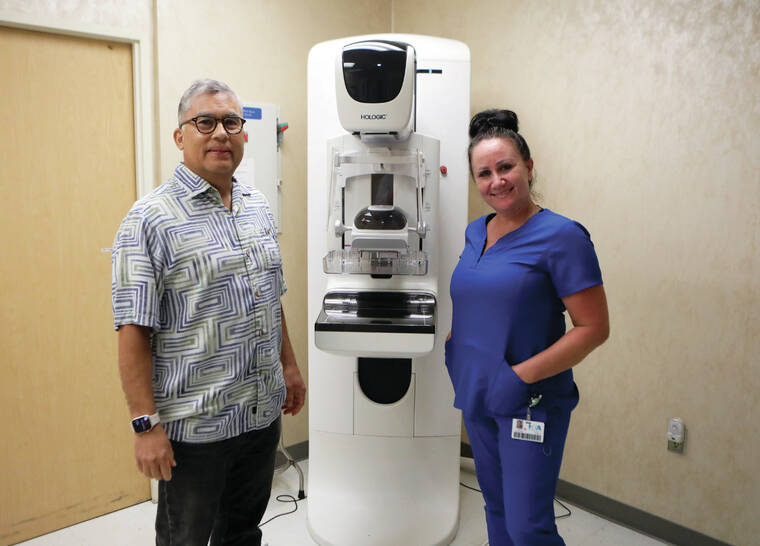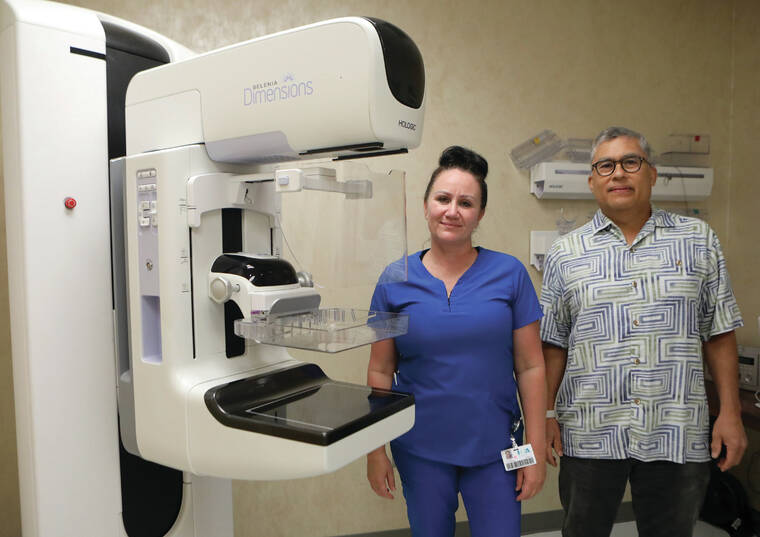The U.S. Preventive Services Task Force is now recommending women start getting every-other-year mammograms at the age of 40 instead of 50, a decision pushed for and supported by the Hawaii Radiological Society.
“It’s not only huge for Hawaii, but it’s good for the nation,” said Hawaii Radiological Society President Dr. Laeton Pang. “Not only that, they’re calling for more research to determine the need for additional screenings like breast ultrasounds and MRIs. These are all things I think we can strongly advocate for.”
The new draft recommendation covers more than 20 million women in the U.S. between the ages of 40 and 49.
“The Hawaii Radiological Society advocated for this,” said Dr. David Camacho, director of the Women’s Imaging Center in Hilo. “They put together all their data for minority women and their recommendation was to go to 40.”
Hawaii has the fifth highest incidence of breast cancer throughout the U.S., with Asian Americans and Native Hawaiians among those hit hardest.
“I think a lot of that has to do with the socioeconomic status of patients,” Camacho said. “And they don’t have easy access to care, especially now, with the state having very few physicians for the population.”
Like most medical professions in Hawaii, there’s an ongoing shortage of radiologists.
“Even now we can always use more mammography techs and more breast ultrasound techs and radiologists too,” Camacho said. “We were a group of 15 on the Big Island, now we’re a group of six.”
Another factor is dense breast tissue, which is found more often in Asian American and Native Hawaiian women.
“The Asian population has been shown to have very dense breast tissue, which gives them a higher risk of breast cancer,” Camacho said. “But also, it’s harder to detect early, that’s why they have to be screened earlier for any changes.”
The American College of Radiology released new guidelines this month that call for earlier and more intensive screenings for high-risk women.
“We all endorse better research so that we know which populations would be better served with advanced screening technologies,” Pang said. “And we need to know which patients would benefit from tomosynthesis.”
Tomosynthesis is a three-dimensional mammogram that uses X-rays to obtain sectional images of the breast, which are then reconstructed into a 3D volume. The procedure is more beneficial for testing women with dense breasts and uses low-dose X-rays, which can minimize radiation exposure.
Due to advocacy from the Hawaii Radiological Society, tomosynthesis is now available throughout the Big Island and the state.
“Hawaii was the state with the lowest availability of tomosynthesis equipment in America a few years ago,” said Big Island Diagnostic Radiologist Scott Grosskreutz. “Now, tomosynthesis is widely available throughout the Hawaiian islands, and it’s important because it improves the sensitivity of mammography and looking for breast cancers in people that have dense breast tissue.”
Grosskreutz added that Hilo is one of the only places in the state that uses whole-breast ultrasound, a secondary, noninvasive screening exam designed for women with dense breasts.
“It takes a lot of work and expertise to do those, but we’ve been doing whole-breast ultrasound as an adjunct to mammography when clinically indicated for almost 30 years now,” he said. “We have found hundreds of cancers at an early stage on ultrasound that could not be seen on the mammogram.”
But even with state-of-the-art equipment, some patients are hesitant to go in for screenings because of a common misconception that a referral from a primary care physician is needed.
“We have women that come in, at least once or twice a month, that delayed work on their breast masses because they couldn’t find a primary care physician to refer them, but this is important: you can self-refer,” Camacho said. “You can actually just walk into this clinic and get a mammogram, that’s always an option.”
Email Grant Phillips at gphillips@hawaiitribune-herald.com









